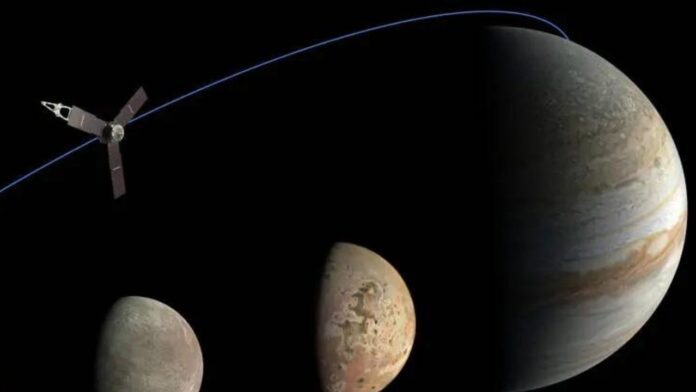NASA’s Juno spacecraft, currently orbiting the gas giant Jupiter on an extended mission, has recently detected the presence of mineral salts and organic compounds on the surface of Jupiter’s largest moon, Ganymede. This groundbreaking discovery provides scientists with new clues into the complex geologic and chemical processes that have shaped this icy, ocean-bearing celestial body over the eons.
Juno’s Instruments Allow Unprecedented Close-Up Study of Ganymede’s Surface
During a remarkably close flyby of Ganymede on June 7, 2021, Juno passed within just 650 miles of its surface. This represented the closest observational pass of the moon in over two decades. As it rapidly approached, the spacecraft’s Jovian InfraRed Auroral Mapper (JIRAM) spectrometer turned its sensors toward the approaching lunar terrain. JIRAM is equipped with specialized detectors designed to collect infrared light from Jupiter’s atmosphere. However, it has proven equally adept at analyzing the infrared signatures of the planet’s Galilean moons. The resolution achieved during this rapid flyby was under 1 kilometer per pixel – the highest ever infrared measurement of Ganymede. This allowed JIRAM to definitively identify non-water-ice substances on the surface. In addition, you can also read an article on- NASA Releases “Ghostly Cosmic Hand” Image Just in Time for Halloween
In-Depth Spectral Analysis Reveals Icy Moon’s Salty, Carbon-Rich Composition
Upon later analysis of the spectral data, the JIRAM team identified absorptions indicative of specific hydrated salts and organic molecules blanketing areas of the ancient, cratered surface. The signatures provided conclusive evidence for materials such as hydrated sodium chloride, ammonium chloride, sodium bicarbonate, and possibly aliphatic aldehydes. The presence of ammonia-rich salts bolsters theories that Ganymede originally formed in an extremely frigid environment, allowing such icy compounds to accumulate. In addition, the identification of sodium carbonates lends credence to models that carbon dioxide was abundant during the moon’s early history and gradually left behind carbonate residue.
Complex Geological Activity Made Possible by Ganymede’s Hidden Ocean
Most notably, these salt deposits and organic materials appear to be concentrated within Ganymede’s older, darker terrains. These regions lie within the protective envelope of the moon’s intrinsic magnetic field, sheltering them from Jupiter’s intense radiation belts. The salts and organics detected in these areas by Juno are likely remnants of past briny ocean fluids that migrated to the surface through cracks and fissures in the ice. The new findings thus provide further evidence that Ganymede harbors a vast subsurface ocean, with complex geological processes governing the icy crust above it. Additionally, you can also read about- NASA’s Revolutionary Asteroid Sample Offers Clues to Life’s Origins on Earth
Juno Continues Revelations on Icy Moons with Upcoming Flybys
As Juno continues orbiting Jupiter, further close passes of other Galilean moons are on the schedule. The next will target Jupiter’s icy ocean moon Europa in 2023, followed by the volcanic world Io. With each flyby, Juno’s instruments are unraveling more of the mysteries surrounding the origins and evolution of these dynamic Jovian satellites. The new insights accelerate our understanding exponentially compared to previous eras of observation. Juno’s ongoing explorations promise to revolutionize our understanding of the outer solar system.
You May Find Interest: NASA Mission to Metal World Could Help Us Find New Resources for Space Exploration




























